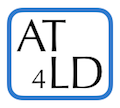AT4LD comprises 10 learning modules (roughly one per week):
- Course overview and defining assistive technology
- Learning objectives, syllabus, and projects (see below)
- Tools to support you as a learner in this course
- Learning Differences and the 1-in-5
- Assistive Technology defined - Key AT Concepts on which course is based
- AT is always tied to function, not disability (correlate functional obstacles and technology features)
- AT solutions are more than just technology (components of an effective "AT solution")
- AT works best in accessible learning environments (Universal Design for Learning and Accessible Educational Materials) - Tools for Processing and Memory
- Visual, auditory, kinesthetic, and sensory processing
- Memory retention and retrieval
- Working memory and concept formation - Tools for Reading
- Decoding and fluency
- Comprehension and vocabulary
- Critical thinking and reasoning - Tools for Written Expression
- Motor aspects of writing
- Composition and writing organization
- Vocabulary and word choice
- Mechanics (spelling, grammar, editing, etc.) - Tools for Math & Science
- Calculation and fluency
- Notation and alignment
- Understand concepts
- Word problems
- Procedural and problem-solving - Tools for Notetaking & Study
- Capturing new learning in class, from reading, and elsewhere
- Organizing and applying new learning - Tools for Attention & Executive Functioning
- Attention and self-regulation
- Organization and memory management
- Planning and productivity
- Cognitive flexibility and self-monitoring - Creating an Assistive Technology Plan
- Applying knowledge of AT tools, strategies, and implementation factors to create an AT Consideration & Implementation Plan for an assigned hypothetical student (see Project #2, below) - Building Your AT Skillset & Course Wrap-up
- Online discussion of student-created AT plans
- Extending your AT professional development
________________
There is also a "Module R" (References, Resources, & Review) for use throughout the course which includes:
- Overview of laws relevant to assistive technology
- State Tech Act Programs & AT Device Loans
- Overview of tools for other selected disabilities you may encounter
- Vision and hearing impairments, alternative computer/device access, augmentative/alternative communication - Overview of Generative AI: What Educators Need to Know
- Background info on learning differences for those who need to brush up on the "Skills Needed" for this course
- Per the course prerequisites: "...basic understanding of the academic challenges faced by individuals who have learning disabilities, ADHD, and executive function issues."
________________
Instruction is primarily online and asynchronous (self-paced) – comprehensive reading material with diagrams, videos, photos, tables, and links to additional web-based resources, plus self-guided hands-on activities. Live weekly Zoom sessions supplement the online instruction and coursework with class discussion and technology assistance (see Schedule tab for details). All instruction is delivered through Canvas, UCSC Extension's Online Classroom platform. Most Zoom sessions can be attended live or viewed later as a recording. Individualized online guidance is also available as needed.
Projects & Discussion Forum
Students will work on two major projects throughout the course.
Project #1: Function-Feature Journal
Key to this course are hands-on activities to better understand how selected technology features address specific functional learning needs. Using a variety of tool features in the context of performing academic tasks, as students would, will provide a greater appreciation of realities concerning tool selection, training, implementation, and application strategies.
Course participants will explore at least two features of their choice for each of Modules 4-8 and maintain a Function-Feature Journal (FFJ) where they will note the tool tried, how the chosen features were used (specific task), and various insights gained. The instructor will provide participants with pre-made structured templates and examples to facilitate FFJ entries. (These templates may be modified, if desired.)
Project #2: Assistive Technology Consideration and Implementation Plan
During the seventh week of the course, each participant will be provided with a one-page summary of a hypothetical student with multiple learning challenges – their functional abilities and limitations, the nature of their curriculum (instructional methods, materials, goals, and assessment), their learning environments at school and at home, and their current academic challenges.
Each participant will create an AT Plan to address one significant functional obstacle for their hypothetical student. To facilitate this project, the instructor will provide participants with an AT Plan template based on the decision-making framework described in the course.
Discussion Forum Topics & Technology Questionnaire
Discussion prompts will be posted for each of Modules 2-8 based on the learning materials and/or hands-on activities. Students are expected to participate in these discussions weekly and will be graded on their contributions to the discussion and interaction with others’ observations. The instructor will provide a template to help keep discussion responses brief (100-200 words) and somewhat standardized.
During the first week of class, students will complete and submit a questionnaire about technology tools they own or have access to. The information will help the instructor advise students throughout the course as questions arise.
